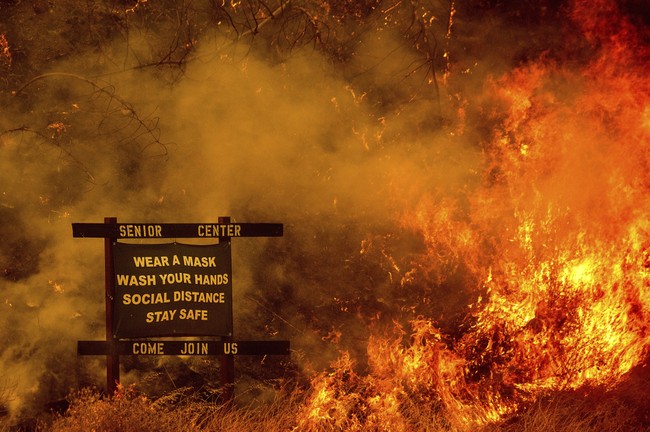On July 30, The New York Times (NYT) ran an article titled “How Did the Park Fire Get So Big, So Fast?” that claims, “Heat has been breaking records all summer, and … records will probably continue to fall over the next several years as the burning of fossil fuels continues to add greenhouse gases to the atmosphere.”
This is false. The article provides no data or citations to support this claim but rather relies on opinions from so-called climate experts who have no direct connection to the fire whatsoever.
Having spent 35 years in Chico, California, the Park fire is one of three recent wildfires that I have personally experienced. The other two were the Camp Fire in 2018 and the Dixie Fire in 2021. All of these fires affected me personally and the people around me.
Somehow, the NYT and their bevy of so-called experts think they can divine the cause of these fires. In each case, the NYT has blamed climate change as either a driver or contributor to these three fires without so much as a shred of proof. In fact, the NYT contradicts their own claims in the table of the top ten fires in California by acreage burned provided in their article.
Climate change isn’t listed as a cause in any of them. However, that doesn’t stop the “experts” they interviewed for the story from trying to make a climate connection where none exists.
By my observations, this sort of causality shoehorning (to coin a phrase) is becoming increasingly common among journalists and climate advocates as they strain to fit any weather event or catastrophe into the climate change narrative.
Swain’s claim of “a very clear fingerprint of climate change” on dry vegetation that fueled the Park Fire is little more than his personal opinion. He offers no scientific citation or basis for his claim.
While there was indeed a heat wave prior to the Park Fire, that had no bearing on the fire at all. The area where the fire ignited, Butte County, California, and the most-burned area in Tehama County are not in drought conditions according to the U.S. Drought Monitor for July 23 – the day before the Park Fire was ignited by a criminal arsonist.
So, “climate change caused drought” creating abnormally dry conditions didn’t figure into the Park Fire at all. The fire wouldn’t exist without the criminal act of arson.
The arson ignition point in Chico’s Bidwell Park is in the foothills of the Sierra Nevada. Just to the north of that point, huge acreages of grassland and scrubbrush exist. Combine that ignition with the sustained southerly winds that day of 20-25 mph, and it is no surprise that the fire rapidly spread north. Rick Carhart, the Public Information Officer for CalFire in Butte County and a Chico resident for decades, confirmed in a telephone interview that the area “had not naturally burned in several decades, and had no control burns to reduce fuel loads.” He added that these “high fuel loads, combined with the wind that day made a very aggressive fire.”
Climate change contributed nothing to the actual circumstances or rapid spread of the fire – local weather and a criminal act are at fault. The drying of grasses (which happens every spring) and the heat wave (which happens every summer) are both weather patterns that operate on short-term time scales as opposed to long-term climate change.
My colleague, Heartland Institute Research Fellow Linnea Lueken, published a scathing factual rebuttal last year of a case with The Sacramento Bee making similar, baseless claims like the NYT when they attempted to connect climate change to wildfires and their natural drivers, such as lightning. She writes:
The Intergovernmental Panel on Climate Change finds no climate signal, nor increasing trend, behind thunderstorms, or lightning occurrences. Also, NASA satellites have documented a global long-term decline in wildfires. NASA reports satellites have measured a 25-percent decrease in global lands burned since 2003.
Examining wildfires in California in particular, research shows massive wildfires have regularly swept through the state. Indeed, a 2007 paper in the journal Forest Ecology and Management reported that prior to European colonization in the 1800s, more than 4.4 million acres of California forest and shrub-land burned annually. As compared to the 4.4 million California acres that burned each year prior to European colonization, only 90,000 acres to 1.6 million California acres burn in a typical year now.
Clearly, there is no climate change component to California wildfires at all. If there were, fires in the present would be consuming much more than 4.4 million acres annually – but this isn’t happening. The simple fact is: Arsonists are responsible for more wildfires than climate change. The intensity and coverage of wildfire varies greatly from year to year, as evidenced by the 2022 NYT story: Why California’s 2022 Wildfire Season Was Unexpectedly Quiet. A map of fires from year to year in the article demonstrates this well.
Of course, they can’t resist blaming climate change, only providing cherry-picked data back to 1990 to bolster their claim while completely ignoring the huge fires of the past.
The NYT believes that they can determine the climate connections to the fire from offices in New York while ignoring the fact that an arsonist was directly responsible for the Park Fire.
It is a shameful and obvious demonstration that the NYT cares more about furthering the climate agenda than they do reporting the facts.
Anthony Watts ([email protected]) is a senior fellow with The Heartland Institute.

